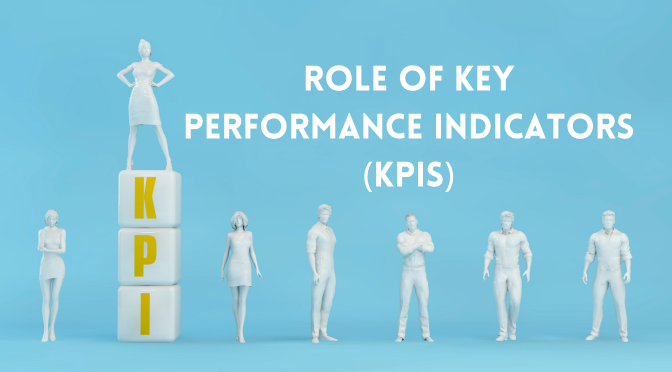In the world of business, Key Performance Indicators (KPIs) are essential tools that provide quantifiable measurements of performance. They are used to gauge the success level of an organisation or of a particular activity that it engages in. Think of KPIs as a business’s compass, guiding it towards its strategic goals and objectives.
However, the concept of KPIs goes beyond mere numbers and percentages. It’s about understanding the health of a business, identifying areas of improvement, and strategising for future success. KPIs serve as the vital signs of a business, indicating whether it is in good shape or needs immediate attention.
Therefore, it is crucial for executives and managers to understand what KPIs are and how they work. This knowledge forms the foundation for making informed decisions, setting strategic goals, and steering the business towards success.
Understanding the importance of KPIs in business
Key Performance Indicators (KPIs) are integral to the world of business, serving as critical metrics for shaping corporate strategy, monitoring progress, and making necessary adjustments to stay on course. These metrics are essential for making informed business decisions, setting realistic goals, and measuring progress toward these goals. Notably, around 60% of organisations actively utilise KPIs to track and evaluate their performance.
KPIs offer a clear view of the company’s current position and play a pivotal role in identifying patterns and trends, which are incredibly beneficial in planning for the future. For instance, 85% of senior executives believe that using KPIs effectively is essential for the success of their business, indicating the widespread recognition of their importance.
Moreover, KPIs foster accountability within the organisation. By establishing clear, quantifiable goals, employees at all levels can understand what is expected of them and work toward achieving these objectives. This sense of responsibility not only boosts employee morale and productivity but also ultimately enhances overall business performance.
How KPIs contribute to business success

The contribution of Key Performance Indicators (KPIs) to business success is invaluable. KPIs provide a clear and quantifiable measure of performance, enabling businesses to track their progress toward strategic goals and make necessary adjustments along the way.
Notably, approximately 68% of businesses actively use data analytics to drive their decision-making processes, highlighting the prevalence of data-driven decision-making in the modern business landscape.
KPIs go beyond internal tracking; they offer a means to communicate progress and achievements within the organisation and to stakeholders. This transparency fosters trust and confidence, leading to increased motivation and commitment from employees. Additionally, organisations that use data-driven decision-making practices are shown to be up to 5% more productive and 6% more profitable than their competitors.
Furthermore, KPIs play a vital role in facilitating decision-making by providing valuable insights into business operations. Managers can leverage KPI data to identify areas of weakness, allocate resources more efficiently, and plan for the future. In this way, KPIs serve as a roadmap to business success, promoting better decision-making, enhanced productivity, and ultimately, greater profitability.
10 Types of key performance indicators
Key Performance Indicators (KPIs) are diverse tools that cater to the multifaceted nature of business performance assessment. They are not one-size-fits-all solutions; instead, they come in various types, each designed to measure different aspects of business performance. Understanding these KPI types is essential for tailoring performance measurement to specific business objectives.
1. Financial KPIs
These metrics focus on the financial health of an organisation and include figures like revenue, profit margin, and return on investment (ROI). Financial KPIs are crucial for assessing the economic viability and profitability of a business.
2. Customer KPIs
These indicators revolve around customer satisfaction, retention rate, and the Net Promoter Score (NPS). Customer KPIs provide insights into how well a business meets customer needs and maintains its customer base.
3. Process KPIs
Process-related KPIs gauge the effectiveness and efficiency of various business processes. They help in identifying areas for improvement, optimising workflows, and enhancing overall operational performance.
4. Performance Management KPIs
These indicators focus on evaluating the performance of employees and teams within an organisation. They are crucial for measuring individual and collective contributions to the company’s success and can include metrics such as employee productivity, goal achievement, and training effectiveness.
Performance Management KPIs help ensure that employees align their efforts with the organisation’s goals and that individuals are meeting performance expectations. This category is vital for optimising human resource management and talent development strategies.
5. Productivity KPIs
Productivity indicators assess the efficiency of operations and resource utilisation. Examples include measures of output per hour worked, units produced per employee, or sales per square foot of retail space. These KPIs are essential for optimising production and resource allocation.
6. Quality KPIs
Quality metrics focus on the level of product or service quality delivered to customers. Common quality KPIs include defect rates, customer complaints, and product return rates. These KPIs are crucial for ensuring that products or services meet or exceed quality standards.
7. Market Share KPIs
Market share indicators help businesses understand their position in the market relative to competitors. These KPIs track the percentage of total market sales or customers that a company captures. They are vital for assessing market competitiveness and market expansion opportunities.
8. Environmental and Sustainability KPIs
With increasing emphasis on sustainability, these KPIs measure an organisation’s impact on the environment. Metrics may include carbon emissions, water usage, or waste reduction. Businesses use these KPIs to demonstrate their commitment to environmental responsibility.
9. Innovation and Research KPIs
These KPIs assess a company’s commitment to innovation and research and development (R&D). Metrics might include the number of new product launches, R&D investment as a percentage of revenue, or the number of patents granted. These KPIs are essential for tracking innovation efforts.
10. Sales and Marketing KPIs
These indicators track the effectiveness of sales and marketing efforts. Common KPIs include conversion rates, customer acquisition cost, and lead-to-sale conversion rates. They are vital for optimising sales and marketing strategies.
Each type of KPI provides unique insights into a specific aspect of the business. Therefore, it’s crucial for organisations to carefully select and focus on the KPIs that align most closely with their goals and objectives. This strategic selection ensures that resources and efforts are directed toward the areas of the business that matter most.
Furthermore, KPIs can be categorised into two main groups: leading and lagging indicators. Leading indicators are forward-looking, predicting future outcomes based on current performance. These are proactive measures that help organisations take timely corrective actions. Lagging indicators, on the other hand, are backward-looking and measure outcomes that have already occurred, providing a historical perspective on performance.
Both leading and lagging indicators are valuable in providing a comprehensive picture of business performance. Leading indicators empower proactive decision-making, while lagging indicators offer insights into past results, facilitating historical analysis and learning from experience. A balanced approach to KPI selection, including both types, ensures a well-rounded assessment of business performance.
8 Steps to identify the right KPIs for your business
Identifying the right Key Performance Indicators (KPIs) for your business is a pivotal step on the path to success. This process hinges on several key considerations:
1. Define clear business goals
Start with a thorough understanding of your business goals and objectives. What are you trying to achieve, and what does success look like for your business? These goals will serve as the foundation for your KPI selection.
2. Industry and business type
Acknowledge that different industries and business types have unique KPI requirements. Consider the nature of your business and the industry in which you operate to choose KPIs that are most relevant to your specific circumstances.
3. Relevance and significance
Not all KPIs are equally valuable. Select indicators that are directly relevant to your business objectives and have a significant impact on your success. Avoid the temptation to track a multitude of metrics, as focusing on a handful of critical KPIs can offer a more precise and actionable view of your performance.
4. Consult with stakeholders
Engage with key stakeholders within your organisation, including department heads, managers, and employees who are directly involved in achieving your business goals. Their insights can provide valuable perspectives on what should be measured and monitored.
5. Benchmark against competitors
Analyse what KPIs your competitors or industry leaders are tracking. Benchmarking against industry standards can offer valuable insights into what metrics are crucial for success and where your business stands relative to others in the field.
6. Consider the customer perspective
Your customers’ satisfaction and expectations are paramount. Assess customer feedback, preferences, and behavior to identify KPIs that are closely aligned with delivering an exceptional customer experience.
7. Set measurable targets
Once you’ve selected your KPIs, establish clear, measurable targets or benchmarks for each one. These targets should be specific, achievable, and time-bound, providing a roadmap for tracking your progress.
8. Regularly review and adapt
Recognise that the business landscape is dynamic, and so should be your KPIs. Regularly review your chosen KPIs to ensure they remain relevant and effective in measuring your business’s progress. Be ready to adapt and refine your KPIs as your business evolves.
By following these steps, you can create a robust and adaptive framework for identifying and utilising KPIs that align with your business goals, industry standards, and the evolving needs of your business and customers. This strategic approach will empower you to measure progress accurately and make informed decisions to drive your business towards success.
Implementing KPIs in your business strategy
Once you’ve identified the right Key Performance Indicators (KPIs) for your business, the next step is to seamlessly integrate them into your overall business strategy. This process involves several key elements:

Set clear, measurable targets
Establish precise and measurable targets for each KPI. These targets should be specific, attainable, relevant, and time-bound (SMART). Clear targets provide a roadmap for employees to understand what is expected in terms of performance.
Communication and alignment
Ensure that these KPI targets are communicated effectively throughout the organisation. Everyone from top management to front-line employees should understand the significance of these KPIs and how they align with the company’s strategic objectives. Alignment and buy-in are crucial for successful KPI implementation.
Regular monitoring and review
KPIs require consistent monitoring and review. This is an ongoing process that involves tracking performance data, assessing progress, and identifying any deviations from the set targets. Regular review allows for timely corrective actions and adjustments.
Data visualisation and reporting
Develop a system for visualising and reporting KPI data. Dashboard tools and reports can help present the information in a clear and accessible manner, enabling quick decision-making and facilitating transparency throughout the organisation.
Actionable insights
Recognise that KPIs are not an end in themselves but a means to an end. While striving for good KPI results is important, it’s equally crucial to understand the underlying factors contributing to these results. Focus on the root causes and areas that need improvement, using KPIs as a diagnostic tool to enhance business performance.
Continuous improvement
Use KPIs to drive a culture of continuous improvement. Encourage employees to be proactive in suggesting and implementing changes based on KPI data, fostering a learning organisation that adapts and evolves to achieve its goals.
Incorporating KPIs into your business strategy is an ongoing effort that requires commitment, communication, and a focus on actionable insights. It’s not just about tracking metrics but about using them as a tool to drive performance improvements and align the entire organisation toward common objectives.
8 Common mistakes to avoid while using KPIs
Highlighted some crucial points about common mistakes to avoid when using Key Performance Indicators (KPIs). Let’s delve into these mistakes further:
1. Overloading with too many KPIs
Focusing on a multitude of KPIs at once can overwhelm your organisation. It can lead to confusion, dilute the focus on core objectives, and create a lack of clarity. Instead, concentrate on a select few critical KPIs that genuinely measure your business’s success.
2. Setting unrealistic targets
While challenging targets can drive improvement, setting unrealistic ones can have adverse effects. It can demotivate employees, lead to stress, and create a culture of fear and failure. Balance challenge with achievability.
3. Ignoring qualitative measures
KPIs often emphasise quantitative data, but qualitative information can provide crucial context and insight. Ignoring qualitative measures such as customer feedback, employee satisfaction, or market research can limit your understanding of performance.
4. Neglecting KPI updates
KPIs should evolve with your business. Neglecting to review and update them as your business changes can render them irrelevant. Regular reviews ensure that your KPIs remain aligned with your business’s evolving goals and objectives.
5. Lack of employee involvement
Employees are essential stakeholders in the KPI process. Failing to involve them in setting and tracking KPIs can lead to a lack of engagement and commitment. Employee input can provide valuable perspectives and insights.
6. KPIs in isolation
KPIs should not be viewed in isolation. They should be considered within the broader context of your business strategy. It’s crucial to understand the interconnections between KPIs and how they contribute to overall success.
7. Using KPIs as a blame tool
KPIs should not be used solely as tools for blaming or punishing employees. Instead, they should serve as instruments for improvement and empowerment, encouraging a culture of learning and growth.
8. Lack of flexibility
Rigidity in KPIs can hinder adaptability. Businesses need to be flexible and willing to adjust KPIs as conditions change or new opportunities arise.
By avoiding these common mistakes and adopting a thoughtful and balanced approach to KPI utilisation, organisations can harness the full potential of these metrics for improved performance and strategic alignment.
10 Tools for tracking and analysing KPIs
You’ve highlighted some essential tools for tracking and analysing Key Performance Indicators (KPIs). Let’s explore these tools further:
1. Google Analytics
Google Analytics is a widely used tool for tracking various web-based KPIs, particularly for websites and online businesses. It provides valuable insights into website traffic, user behavior, conversion rates, and more. Google Analytics is user-friendly and offers both free and premium versions.
2. Tableau
Tableau is a robust data visualisation tool that empowers users to create interactive and shareable dashboards. It allows for in-depth analysis and visualisation of data, making it easier to identify trends and patterns in your KPIs. Tableau is known for its ease of use and powerful features.
3. Microsoft Power BI
Microsoft Power BI is a suite of business analytics tools that allows you to connect to various data sources, transform data, and create interactive reports and dashboards. It is especially useful for organisations that rely on Microsoft products and services.
4. Excel and Spreadsheets
While not as advanced as dedicated business intelligence tools, Excel and other spreadsheet software can be effective for tracking and analysing KPIs. They offer flexibility and are widely accessible. You can create custom KPI dashboards and reports in Excel.
5. Business intelligence (BI) Software
Various BI software solutions, such as Tableau, QlikView, and Domo, offer comprehensive features for tracking, analysing, and visualising KPIs. These tools often integrate with multiple data sources and provide advanced analytics capabilities.
6. Cloud-based KPI platforms
There are cloud-based platforms like Databox, Klipfolio, and Geckoboard designed specifically for tracking and visualising KPIs. These platforms streamline the process of KPI monitoring and reporting.
7. Custom dashboard solutions
Some organisations prefer to build custom dashboards and reporting solutions tailored to their specific needs. These may involve web development or the use of APIs to connect to data sources.
8. IBM Cognos
IBM Cognos is a business intelligence and performance management software that offers a range of tools for reporting, dashboards, scorecards, and analytics. It allows organisations to create and distribute interactive reports and explore data for better decision-making.
9. Looker
Looker is a data exploration and business intelligence platform that connects directly to your data sources. It enables organisations to create custom KPI dashboards, explore data, and build interactive visualisations. Looker is known for its data modeling and exploration capabilities.
10. Sisense
Sisense is a business intelligence platform that offers data integration, analytics, and visualisation. It provides a user-friendly interface for creating interactive dashboards and reports. Sisense is particularly suited for organisations looking to combine and analyse large datasets.
The choice of a KPI tracking and analysis tool should align with your organisation’s requirements, including the complexity of your KPIs, the volume of data to be handled, and your team’s familiarity with the tool. These tools not only make tracking and analysing KPIs more efficient but also provide valuable insights to inform business strategy and decision-making.
Conclusion
In conclusion, Key Performance Indicators (KPIs) hold a pivotal role in steering businesses toward success. They offer a quantifiable and clear means of gauging performance, enabling organisations to track progress, make well-informed decisions, and chart a course for future achievements.
By selecting the right KPIs that align with their objectives, setting realistic and achievable targets, and diligently monitoring and analysing performance data, businesses can harness the transformative power of KPIs. These metrics are not mere numbers; they are the compass that guides businesses on the path to realising their strategic goals and driving continuous improvement. KPIs are more than a measurement; they are a driving force for business success.



